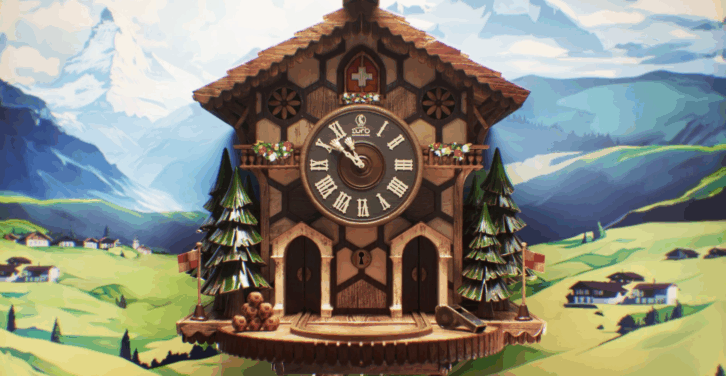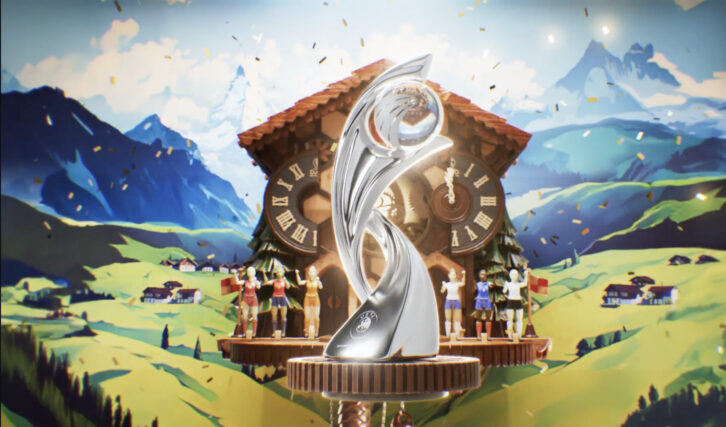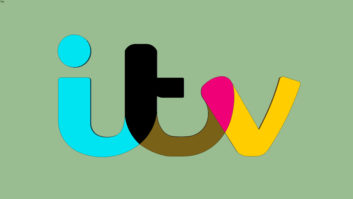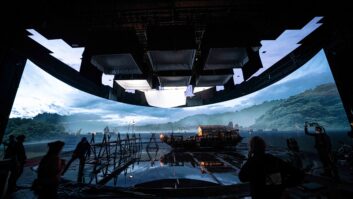With the UEFA Women’s Euro 2025 now underway, British fans are being treated to iconic images of host country Switzerland as part of ITV Sport’s title sequence.
The titles were created for ITV by Ignite, the creative agency arm of AE Live Group, with a team based in London and New Zealand led by creative producer David Snowdon.
Ignite won the contract to create the title sequence after being invited to submit a proposal by ITV. “As soon as the brief came in, we jumped straight into concept development,” Snowdon tells TVBEurope.
Snowdon had previously worked with ITV on creating titles for its coverage of the FIFA World Cup 2022 and Euro 2024. That gave him a strong understanding of the broadcaster’s brand pillars and the type of title sequence that would resonate with viewers.
“We spent some time researching Switzerland to see if there were any cultural devices we could use as a hook, and we quickly realised that the cuckoo clock would be a great creative vehicle to base our concept on.

“With Ignite’s hugely talented motion design team, we knew the sequence would be planted firmly in a 3D world, so I grabbed a pencil and paper and quickly drew out what I thought it could look like, with different platforms featuring various scenes that we could travel through.”
He then sat down with Ignite creative director Andrew Olley to create a strong concept. They shared the idea with the wider team and the cuckoo clock world began to take shape.
“To represent the players, we discussed the need for them to look like they were carved out of wood and our designer Jamie Burton began to work on the design,” adds Snowdon. “We put together a storyboard, created style frames and went to ITV Sport’s HQ to present our proposal to executive director, Paul McNamara. We found out a week later that we were successful and that kick-started production.”
Snowdon says one of the biggest aims of the title sequence is to “put a smile on people’s faces” while appealing to both football fans and casual viewers. “We wanted to have enough detail in it to make multiple viewings constantly enjoyable. We also wanted it to stand shoulder to shoulder with title sequences for men’s sports and have a feeling of high production value.”
The Ignite team used a number of tools to create the titles. All the scenes were built and animated in Cinema 4D and refined and edited in Adobe After Effects. Lighting and rendering were handled entirely with RedShift. The team used ZBrush for asset building and Adobe Substance Partner for textures. Final renders were imported into After Effects and then to Premiere Pro to marry the pictures with the titles’ music. The final sequence was exported for delivery on Frame.io.

In total, the team at Ignite (10 full-time, four freelancers) spent 209 days creating the final product. “That wasn’t all spent on the title sequence though as we also had to create over 50 individual break bumpers as well as several transition wipes, looping backgrounds and closing sequences, not to mention working with composer Jim Copperthwaite to create a bespoke track as well as break bumper stings and musical beds,” explains Snowdon.
He is quick to credit ITV as a “genuinely brilliant client to work for”, citing what he describes as a “trust-based partnership” with the broadcaster. “As soon as we were awarded the project, I drafted a production schedule with key milestones that had to be hit and catch-up meetings with Paul McNamara.
“These calls were roughly every other week during production, where he would challenge decisions we were taking but in a way that improved the creative, not hinder it. ITV Sport’s production manager, Denise Jones was hugely supportive and assisted us constantly throughout production, particularly when it came to communications with UEFA’s branding department.”
Like any major project, there were challenges Snowdon and the Ignite team had to overcome during production, beginning with creating a sense of scale for the title sequence. “We knew what elements we wanted – a train, the Alps, a disco ball, etc. but how would they fit inside our world alongside our players from scene to scene? Kasun Ilesinghe, senior motion designer at Ignite New Zealand, did a great job in overcoming this, but it was the main subject of many meetings.
“Time is also a challenge when producing a title sequence, with a hard deadline to hit and with so many moving parts, it is important to keep on top of everything and know when to spend more time refining elements and when to move on.”
Snowdon, a football fan, describes the project as falling under the “dream job” category. “It’s an amazing feeling to be sitting at home or in a bar with friends and something you have had a part in creating appears on the TV. The hardest part of being a creative producer is how subjective what we do is. You may think you have a great idea, but others don’t and it’s hard not to take that personally. It is really rewarding when the pieces all fall into place and at the end of a project you can be proud of what you and your team have achieved.”







